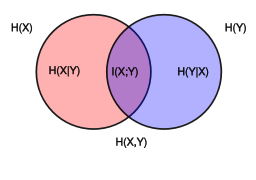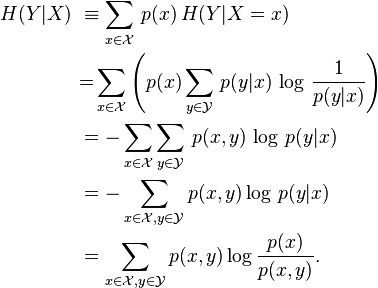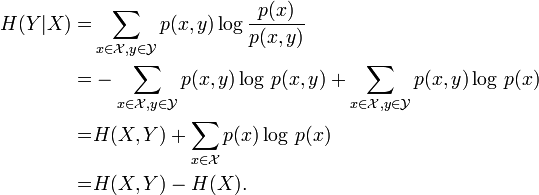Conditional entropy

In information theory, the conditional entropy (or equivocation) quantifies the amount of information needed to describe the outcome of a random variable  given that the value of another random variable
given that the value of another random variable  is known.
Here, information is measured in bits, nats, or bans.
The entropy of
is known.
Here, information is measured in bits, nats, or bans.
The entropy of  conditioned on
conditioned on  is written as
is written as  .
.
Definition
If  is the entropy of the variable
is the entropy of the variable  conditioned on the variable
conditioned on the variable  taking a certain value
taking a certain value  , then
, then  is the result of averaging
is the result of averaging  over all possible values
over all possible values  that
that  may take.
may take.
Given discrete random variable  with support
with support  and
and  with support
with support  , the conditional entropy of
, the conditional entropy of  given
given  is defined as:[1]
is defined as:[1]
Note: The supports of X and Y can be replaced by their domains if it is understood that  should be treated as being equal to zero.
should be treated as being equal to zero.
 if and only if the value of
if and only if the value of  is completely determined by the value of
is completely determined by the value of  . Conversely,
. Conversely,  if and only if
if and only if  and
and  are independent random variables.
are independent random variables.
Chain rule
Assume that the combined system determined by two random variables X and Y has entropy  , that is, we need
, that is, we need  bits of information to describe its exact state.
Now if we first learn the value of
bits of information to describe its exact state.
Now if we first learn the value of  , we have gained
, we have gained  bits of information.
Once
bits of information.
Once  is known, we only need
is known, we only need  bits to describe the state of the whole system.
This quantity is exactly
bits to describe the state of the whole system.
This quantity is exactly  , which gives the chain rule of conditional entropy:
, which gives the chain rule of conditional entropy:
Formally, the chain rule indeed follows from the above definition of conditional entropy:
Generalization to quantum theory
In quantum information theory, the conditional entropy is generalized to the conditional quantum entropy. The latter can take negative values, unlike its classical counterpart.
Other properties
For any  and
and  :
:
 , where
, where  is the mutual information between
is the mutual information between  and
and  .
.
where  is the mutual information between
is the mutual information between  and
and  .
.
For independent  and
and  :
:
Although the specific-conditional entropy,  , can be either less or greater than
, can be either less or greater than  ,
,  can never exceed
can never exceed  when
when  is the uniform distribution.
is the uniform distribution.
References
See also
- Entropy (information theory)
- Mutual information
- Conditional quantum entropy
- Variation of information
- Entropy power inequality
- Likelihood function






